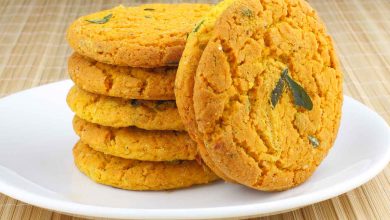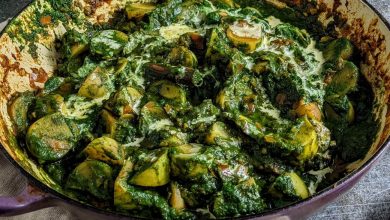Chakolaya Recipe (Maharashtrian Varan Phal)
Exploring the Heart of Maharashtrian Cuisine
Chakolaya, also known as Maharashtrian Varan Phal, is a quintessentially rich and comforting dish from the heart of Maharashtra, India. This recipe, though often compared to the Rajasthani Dal Dhokli, brings a unique flair with its combination of whole wheat dumplings and a hearty toor dal mixture. The dumplings are cooked in a seasoned dal, which absorbs the flavors and spices, making every bite a harmonious blend of textures and tastes. The dish is comforting yet robust, perfect for a nourishing lunch or dinner.
The distinct taste of Chakolaya comes from the perfectly balanced blend of spices—red chili powder, turmeric, and coriander powder—along with the sharpness of mustard seeds and the tartness of kokum, a Malabar tamarind. These spices are complemented by the subtle sweetness of sugar and the tanginess from the kokum extract, resulting in a complex yet comforting flavor profile. Traditionally, Chakolaya is served hot, garnished with fresh coriander and chopped onions, offering a delightful crunch to the soft dumplings.
Ingredients:
For the Dumplings (Chakolaya):
| Ingredient | Quantity |
|---|---|
| Whole Wheat Flour | 2 cups |
| Oil | 1 teaspoon |
| Ajwain (Carom Seeds) | 1/4 teaspoon |
| Salt | As required |
For the Dal:
| Ingredient | Quantity |
|---|---|
| Arhar Dal (Split Toor Dal) | 3/4 cup |
| Red Chilli Powder | 1 teaspoon |
| Coriander Powder (Dhania) | 1/4 teaspoon |
| Turmeric Powder (Haldi) | 1/4 teaspoon |
| Mustard Seeds (Rai/Kadugu) | 1/4 teaspoon |
| Oil | 1 tablespoon |
| Kokum (Malabar Tamarind) | 2 pieces (soaked) |
| Sugar | 1 teaspoon |
| Water | As required |
For Garnish:
| Ingredient | Quantity |
|---|---|
| Onion (small, chopped) | 1 piece |
Allergen Information:
This recipe contains gluten from the whole wheat flour used in the dumplings and legumes (toor dal). While the dish is vegetarian, it is important to note that some people with sensitivity to soy or beans might want to avoid it. The dish is also not suitable for individuals who are allergic to mustard seeds or have a sensitivity to tamarind.
Dietary Preferences:
- Vegetarian: The recipe is plant-based and does not contain any animal products.
- Vegan: The recipe can be made vegan by using a plant-based oil or omitting ghee (clarified butter) from the garnishing.
- Gluten: The recipe contains gluten due to the wheat flour used in making the dumplings. It is not suitable for those following a gluten-free diet.
Preparation Time: 10 minutes
Cooking Time: 40 minutes
Instructions:
-
Prepare the Dumplings:
- In a mixing bowl, combine the whole wheat flour, salt, ajwain (carom seeds), and oil. Gradually add water and knead into a stiff dough. The dough should be firm enough to hold its shape while cooking.
- Once the dough is ready, divide it into equal portions and roll each portion into small balls. Roll out each ball into a flat disc, and make horizontal and vertical cuts using a knife to form square or diamond-shaped pieces. Place the cut pieces aside on a plate, ready for cooking.
-
Cook the Toor Dal (Split Yellow Lentils):
- In a pressure cooker, cook the toor dal with garlic (optional) for 3-4 whistles or until the dal is soft and cooked through.
- Once the dal is cooked, mash it well to ensure a smooth consistency.
-
Prepare the Tempering for the Dal:
- In a separate pan, heat the oil. Add mustard seeds to the oil, and once they splutter, add turmeric powder, red chili powder, and coriander powder. Stir well and sprinkle some water to form a paste-like consistency.
- Add this tempering mixture to the mashed dal, and stir to combine.
- Now, add the soaked kokum extract to the dal, along with 2-3 cups of water, to create a slurry-like texture. Adjust the water depending on your desired consistency of the dal.
- Let the dal simmer on low heat for a few minutes, allowing the flavors to meld together.
-
Cook the Dumplings in the Dal:
- Once the dal has started to boil and the flavors have developed, gently slide the prepared dumpling squares (chakolaya) into the simmering dal.
- Cook the dumplings on medium heat for about 15 minutes, or until they are fully cooked. You’ll notice that the dumplings will absorb the flavors from the dal, becoming soft and tender.
-
Final Touches and Serving:
- Once the dumplings are cooked, serve the Chakolaya hot, garnished with a dollop of ghee and a sprinkle of fresh chopped coriander.
- For an extra burst of freshness, garnish with some finely chopped onions. The crunchy onions add a delightful contrast to the soft, savory dumplings.
Serving Suggestions:
Chakolaya can be served as a hearty meal on its own or paired with a side of raita (yogurt dip) or a simple vegetable salad. For a more filling meal, you can also pair it with a portion of steamed rice or chapati.
Advice for Cooking Chakolaya:
- If you prefer a spicier version, feel free to adjust the amount of red chili powder according to your taste.
- Be careful not to overcook the dumplings, as they can become too soft and break apart. Keep an eye on them while they cook in the dal.
- If you don’t have kokum, you can substitute it with a small amount of tamarind paste for a similar tangy flavor.
- For a richer texture, you can add a dollop of ghee on top of the Chakolaya just before serving.
Conclusion:
Chakolaya, a Maharashtrian specialty, is a dish that beautifully combines simple ingredients into a flavorful, satisfying meal. The soft, wheat-based dumplings absorb the rich flavors of the spiced toor dal, making it a comforting and wholesome dish. Ideal for a lunch gathering or as a fulfilling dinner, Chakolaya offers a taste of Maharashtra’s culinary traditions. The unique use of kokum and mustard seeds sets it apart from similar dishes like Rajasthani Dal Dhokli, adding a distinctive regional flavor that is sure to captivate the taste buds of anyone who tries it.
This recipe provides a perfect balance of nutrition, flavor, and texture—ideal for those seeking a heartwarming, vegetarian dish with an authentic Maharashtrian touch.




